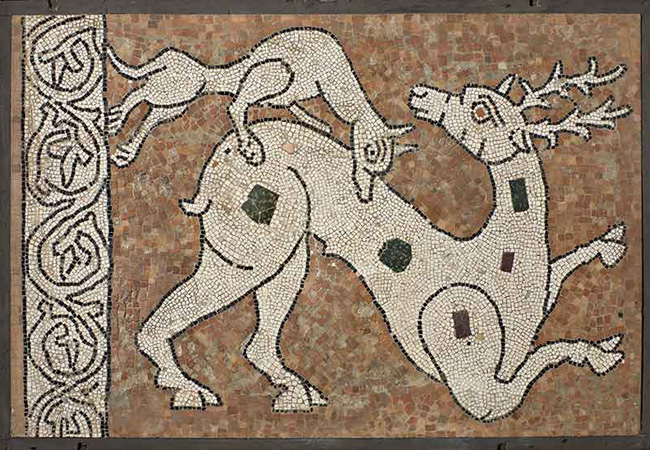Vestibule and atrium
Vestibolo e atrio
The vestibule and atrium in the Musei Civici host a precious collection of mosaic fragments of Roman and Medieval origin which arrived from digs and finds at private homes and religious buildings in the city.
Discentium commodo, advenarum spectaculo (“for serving study, for the pleasure of visitors”) is the inscription painted on the portal at the entrance, and it explains the purposes of the Museum – a veritable temple of homeland memories. From 1873 to 1878, Gaetano Chierici laid out the arrangements in the vestibule, and then in the atrium. His project for exhibiting the artefacts is presumed to have been finished by Naborre Campanini from 1910 to 1920.
The southern wall of the vestibule hosts collections of coloured items in marble and portions of mosaic tile flooring with geometric areas painted in white and black, which were taken from private residences in the centre of the ancient Roman city of Reggio. Worth special mention are several multicoloured fragments – one with a pelta (a typical shield of the Amazons) from Villa Levi; two with grapevine shoots, from via Toschi and the Cathedral; and one with a bird and kantharoi (wine cups), again from the Cathedral area. The mosaic fragments on the western wall of the vestibule belong to a lithostratum from the Medieval church of San Prospero in Reggio, a building that was reconstructed in Renaissance style in the XVI Century. Following their discovery in 1844, the mosaics were detached and partially relocated inside the Musei Civici in 1873, while the remaining fragments were sold to a craftsman specialising in the Scagliola technique. According to an initial assessment made by Ferrante Bedogni when the mosaic was discovered, two concentric discs were depicted: months personified using images of farm activities were contained in the first disc, and images of the twelve signs of the Zodiac were shown in the second. The spaces around the outer disc are the source for fragments of images of horsemen, men armed with lances and swords, struggles between men and animals, a giant demonic mask, and the rear of a quadruped, probably a centaur.
These depictions were originally placed inside geometric borders and frames.
In the left-hand arcade in the atrium, Chierici arranged two sections of mosaic with small white crosses on a black background, obtained from the via Emilia in San Pietro. On the other hand, the attractive mosaic fragments in white and black with an elegant design (I Century B.C.) once graced a dwelling with a complex structure that was brought to light in the area around the Stallion Depot. The wall in front of the entrance plays host to mosaic fragments from the Medieval floor in the Cathedral of Reggio Emilia. A relief executed by painter Lazzaro Pasini and found by don Gaetano Chierici in 1879 when the floor was resurfaced is all that remains of the entire complex. Using the relief, we can reconstruct the lost sections and original arrangement of the fragments now displayed in the Museum atrium. The mosaics in the atrium are part of two series that are both placed inside a decorative system of geometric frames and a quincunx. The first series, with images such as Two Raptors with Intertwined Necks and Deer Attacked by a Wolf, dates back to the final decades of the XI Century, while images such as Milio the Bell Maker and Friar Offering a Wineskin to a Boy are probably from the second quarter of the XII Century
In 1919, digs at a depth of around two metres in the area where the Church of San Giacomo Maggiore once stood uncovered fragments of a mosaic floor depicting months personified using images of farm activities, along with the relative astrological signs and lunar phases, in a system of twelve spaces. The floor was commissioned by Archdeacon Achille Tacoli, who presumably had the church built from 1140 to 1150. The mosaics seem to date back to the early XIII Century, and the fragments displayed in the Museum show partial depictions of several months (December, January and May) with their relative astrological signs, along with signs that have no corresponding month, as is the case of Pisces and Capricorn. These images are accompanied by a human profile that probably represents a lunar phase and by several fragments of an inscription running around the floor.
On the right-hand wall adjacent to the entrance to the atrium, we find mosaic fragments dating back to the end of the XII Century that were taken from San Tommaso Church (no longer standing) in Reggio Emilia. Because of the extremely fragmentary nature of this series of mosaics, an overall conception of the floor decoration is impossible; however, it is assumed to have been a decorative system arranged into tondos connected together by vine shoots that were enhanced with marble inlays of a different type. The images inside the tondos followed the astrological year, as suggested by the fragments we received in which the signs of Cancer, Aquarius and the Spring are depicted, accompanied by decorative fragments and epigraphs.
Completing the layout of the vestibule and the atrium are several Roman amphorae. Part of this collection was obtained from Goleto di Boretto, and part from Reggio Emilia (the area of the old slaughterhouse).
address
via Spallanzani, 1
42121 Reggio Emilia
T. +39 0522 456816
offices
via Palazzolo, 2
42121 Reggio Emilia
T. +39 0522 456477
F. ’39 0522 456476

